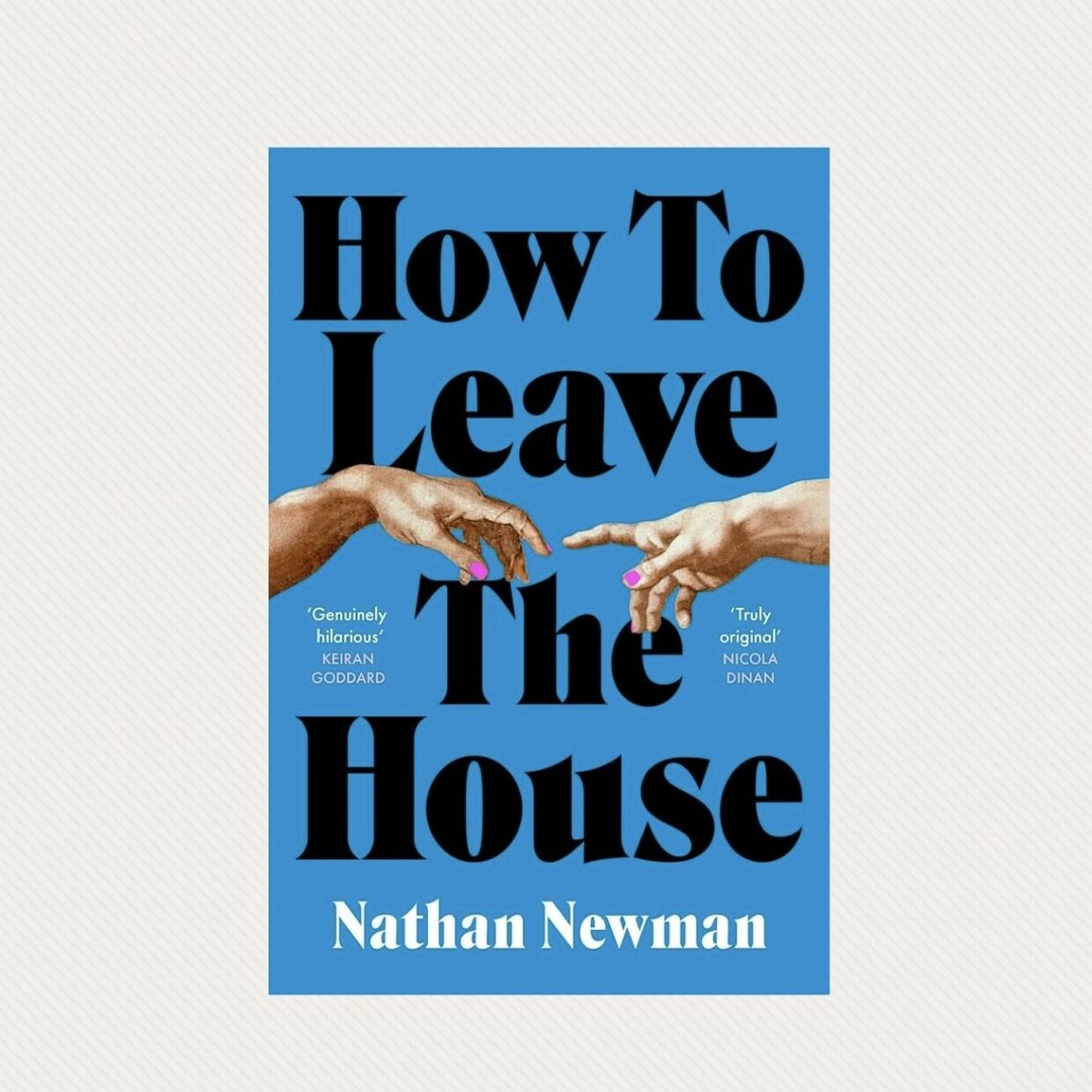I recently took a trip to Lake Como, and to endure flights, travel, and duty free, a book was a must. Luckily, not long before, I had requested a proof copy of an interesting debut novel that had caught my eye. It was How to Leave the House by Nathan Newman.
Since I had decided only to take hand luggage in exchange for cheaper flights, it meant I had to carry Nathan’s novel under my arm for the majority of the trip. It was a great accessory, given the bright blue cover which adorns a cropped version of Michaelangelo’s The Creation of Adam, yet on the cover of Nathan’s novel, both figures have pink painted nails.
The moment I read the first page felt like a breath of fresh air. Newman’s vibrant and distinct talent is clear from the get go. So good, in fact, that I even read it in the car on the way to and from the airport; which says a lot coming from me, as reading in the car gives me extreme motion sickness. The events in How to Leave the House take place over the course of one day. We are immediately introduced to Natwest, our protagonist, who has ordered a parcel that has not yet arrived. It is crucial that Natwest gets his parcel before he leaves for university, due to its questionable contents. The parcel landing in the wrong hands would result in disaster. At least, to Natwest’s belief. And so, there unfolds a series of events and characters that are extremely reminiscent of a Shakespearian comedy, full of colloquialisms, euphemisms, mishearings, misunderstandings (with colossal consequences), a hint of tragedy, and a fabulous ensemble cast.
With the occasional return to Natwest’s side of the story, each chapter of Newman’s novel focuses on a different character, allowing them to be central and additionally allowing the reader to embrace and connect with the community in which Natwest lives. Newman states on their Instagram (@nathanfnewman) that ‘Natwest, like all of us, has been fooled into thinking he is the protagonist of his own world, as opposed to a minor incident in other peoples.’ It is a mindset we are all guilty of occasionally owning that How to Leave the House illustrates perfectly. It is poignant, powerful, and a reminder of the domino effect done both hilariously and emotionally. Nathan Newman has burst into the literary scene with the wit of Wilde, yet by introducing a contemporary, individual, and memorable voice. I was lucky enough to ask them some questions about their writing experience and wonderful book.
Thank you for letting us speak with you, Nathan. First of all, would you mind telling us a little about your writing journey, and what it was that inspired you to write your first novel?
Nathan: The inspiration for How to Leave the House arrived all at once – one night in early 2021. I’d had a terrible shift at the cinema I worked in – a dreadful evening of children vomiting, vacuums breaking, fire alarms ringing – and I was exhausted. On my bus ride home I got off a stop early and walked the extra ten minutes for some fresh air. I remember – as I shuffled back to my flat at 1 a.m. – wishing I could capture this feeling in fiction. I didn’t succeed, partially because the idea transformed into something much more comic when I arrived home: the eagerly anticipated package which I’d spent most of that terrible day dreaming of, which I had counted on to lift my spirits, had vanished without a trace. Cue an insane, breathless search for the missing package, a totally unreasonable panic attack, and a sleepy confrontation with a violent neighbor. The next morning I had the beginning of my novel.
• Your book features some incredibly written three dimensional and unique characters. What was it about Natwest that made you want to place him as the central character in your book?
Nathan: He seemed like a useful figure to put at the centre of the book because, like most of us, he believes he is the main character of his own world, as opposed to a minor incident in other peoples’. The form of the novel came very naturally from his irritating, comic solipsism – a way of upending all his illusions around his own subjectivity.
• How to Leave the House contains lots of plots that intertwine and overlap. How did you plan the ways your characters crossed paths, and did you find it difficult to link them all together?
Nathan: There was a fair amount of planning before I started writing – but perhaps less than it might seem. My initial goal was to have everyone link to Natwest tangentially, and really have nothing to do with him at all. It became clear that would not be satisfying or engaging – or at least I couldn’t pull it off well enough – so the characters’ journeys become more entwined with Natwest’s as the novel goes on, and as a result there was a lot of rethinking specifically where each of the characters were in the town at every point in the 24 hours that the novel unfolds. There was a lot of editing to smooth out any inconsistences and plot holes on subsequent drafts – I think we sorted them all out in the end!
• A moment in your book I loved was the sequence where Natwest cut his thumb, and a few pages later, is told by his Mum to stop acting like a baby (he replies to her while sucking blood from his thumb.) I feel like this simple moment shows your talent in foreshadowing and building humourous moments & tension. Are they planned before you write, or do they come to you naturally while writing?
Nathan: I often find description tedious to read – unless it’s written by a really, really great prose stylist – but it’s always necessary to some degree for texture, character development, and so forth. As such, when I write I always try to “pay off” any description I’m forced to commit to the page with a joke, or a call-back, or an interesting inversion/recapitulation later in the text. I think the thumb joke is one of those. Mostly this stuff comes as I write, but sometimes I will have an image in mind before starting a chapter that I’m confident I can get something funny or interesting out of.
• Your novel features some very funny moments, but also some incredibly tender, serious moments. How do you balance out these two mediums?
Nathan: I was never really worried that the tonal shifts would be too drastic, or off-putting – especially as we are constantly moving from perspective to perspective anyway. I think readers can hold all of these tones in their head at once, especially younger people – it’s pretty much a constant in post-internet life, isn’t it?
• Finally, do you have any tips or advice for aspiring writers?
Nathan: I’m very bad at giving advice because I never seem to follow it myself. I would be a much better writer if I did!
Don’t be afraid to make your characters unlikable, or irritating, or complicated – be honest about how they feel and what they think – and don’t be afraid that readers will think you feel the same way.
And the best guidance is the simplest: write, write, write – then write some more. I say this while currently playing my twenty-sixth round of Bloons Tower Defence 6, doing everything possible not to follow my own advice.
I would like to send Nathan a huge thank you again for answering these questions.
Grab your copy of How to Leave the House here!
Anna Edwards

